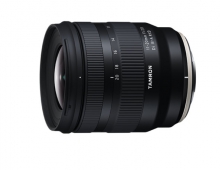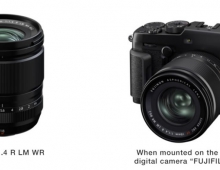
Fujifilm Introduces DVD+R Double Layer Media
Fuji Photo Film U.S.A., Inc. today announced the addition of 8.5 GB DVD+R Double Layer (DL) recordable discs to the company's portfolio of recording and storage products.
The new media was designed for the new double-layer recording drives recently announced by several manufacturers.
New digital video and imaging technologies are driving consumer demand for increased storage capacity for a variety of personal uses. The DVD format has become a popular choice for recording and archiving data. According to NPD Group, the number of desktop computers sold through retail that have DVD recordable drives has risen from 25 percent to 45 percent in the 18 months ending June 2004.
"The ability to share and archive a new generation of visual data is driving new technologies that are increasing quality and capacities at a tremendous rate," noted James Cito, Optical Products Manager, Recording Media Division, Fuji Photo Film U.S.A. "Fujifilm has always been committed to providing technology that helps the industry push the next generation of products."
The Fujifilm DVD+R DL media achieves a total 8.5 GB on a single disc by writing data at 2.4X speed onto two separate dye layers. The movie industry has being using double layer recording technology for years to produce and distribute major motion pictures on DVD-ROM for the home market. Because the standards needed to play those DVDs are already built into existing DVD players, Fujfilm DVD+R DL discs will be able to be replayed on most existing DVD players and DVD-ROM drives already installed in the market.
New Consumer, Business Applications Need Added Capacity
New higher capacity DVD media are ideal for archival, storage and retrieval of high-capacity data files such as photos and video or PC and network backup in home and business environments. A single 8.5 GB DVD+R DL disc can hold the data equivalent of:
-- 12 Compact Discs (CD);
-- 2,000 MP3 formatted songs; or
-- 240 minutes of DVD quality video
Companies that are creating DVD presentations and educational seminars will be able to now distribute large amounts of data on a single disc while IT managers will have another option for backing-up desktop systems or creating single-disc system "images" for configuring client PCs for rapid deployment of new computers on corporate networks.
About Dual Layer Recording
Fujifilm DVD+R DL media utilize two dye-recording layers sandwiched between two polycarbonate bases and semi-reflective layers. Each recording layer consists of a "wobbled pre-groove" track that controls the rotation speed and addressing for that layer. A laser optic system focuses a beam of light on the dye layers, first "burning" the data to one layer, and then refocusing on the underlying layer to complete the recording.
The make up of the recording dye is very important to its ability to receive a pulse of energy from the laser that records the digitized data - while the disc is spinning at a very high speed. Additionally, in a double layer disc the energy must pass through one layer in order to record to the second layer. While a spacer layer separates the two recording layers to prevent cross layer recording, the dye formulation and recording "grooves" in dual layer discs must be optimized to minimize error.
The Fujifilm DVD+R DL media will be available in multiple disc packs and specialized use formats in Q4 2004 through key distributors, resellers and retail stores. For more information, call 800-800-FUJI or go to www.fujifilm.com.
New digital video and imaging technologies are driving consumer demand for increased storage capacity for a variety of personal uses. The DVD format has become a popular choice for recording and archiving data. According to NPD Group, the number of desktop computers sold through retail that have DVD recordable drives has risen from 25 percent to 45 percent in the 18 months ending June 2004.
"The ability to share and archive a new generation of visual data is driving new technologies that are increasing quality and capacities at a tremendous rate," noted James Cito, Optical Products Manager, Recording Media Division, Fuji Photo Film U.S.A. "Fujifilm has always been committed to providing technology that helps the industry push the next generation of products."
The Fujifilm DVD+R DL media achieves a total 8.5 GB on a single disc by writing data at 2.4X speed onto two separate dye layers. The movie industry has being using double layer recording technology for years to produce and distribute major motion pictures on DVD-ROM for the home market. Because the standards needed to play those DVDs are already built into existing DVD players, Fujfilm DVD+R DL discs will be able to be replayed on most existing DVD players and DVD-ROM drives already installed in the market.
New Consumer, Business Applications Need Added Capacity
New higher capacity DVD media are ideal for archival, storage and retrieval of high-capacity data files such as photos and video or PC and network backup in home and business environments. A single 8.5 GB DVD+R DL disc can hold the data equivalent of:
-- 12 Compact Discs (CD);
-- 2,000 MP3 formatted songs; or
-- 240 minutes of DVD quality video
Companies that are creating DVD presentations and educational seminars will be able to now distribute large amounts of data on a single disc while IT managers will have another option for backing-up desktop systems or creating single-disc system "images" for configuring client PCs for rapid deployment of new computers on corporate networks.
About Dual Layer Recording
Fujifilm DVD+R DL media utilize two dye-recording layers sandwiched between two polycarbonate bases and semi-reflective layers. Each recording layer consists of a "wobbled pre-groove" track that controls the rotation speed and addressing for that layer. A laser optic system focuses a beam of light on the dye layers, first "burning" the data to one layer, and then refocusing on the underlying layer to complete the recording.
The make up of the recording dye is very important to its ability to receive a pulse of energy from the laser that records the digitized data - while the disc is spinning at a very high speed. Additionally, in a double layer disc the energy must pass through one layer in order to record to the second layer. While a spacer layer separates the two recording layers to prevent cross layer recording, the dye formulation and recording "grooves" in dual layer discs must be optimized to minimize error.
The Fujifilm DVD+R DL media will be available in multiple disc packs and specialized use formats in Q4 2004 through key distributors, resellers and retail stores. For more information, call 800-800-FUJI or go to www.fujifilm.com.





















